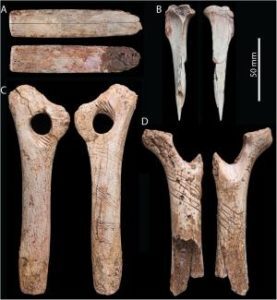
PLOS—Human bones may have been engraved as part of a cannibalistic ritual during the Paleolithic period, according to a study* published August 9, 2017 in the open-access journal PLOS ONE by Silvia Bello from The Natural History Museum, UK and colleagues.
Human bones bearing cuts and damage are frequently found at Magdalenian (approximately 12 to 17,000 years BP) European sites and one of the most extensive assemblages can be found at Gough’s Cave in Somerset, UK. Previous analysis of the human bones from the site found evidence of human cannibalism, but paleontologists debate about whether some of the marks found on the bones were intentionally engraved or simply the result of butchery.
The authors of the present study examined a right human radius excavated in 1987 at Gough’s Cave. The bone had been modified by cut marks, percussion damage and human tooth marks, as well as unusual zig-zagging cuts on one side. To investigate whether these zig-zagging cuts were a result of intentional engraving of the bone, the researchers used macro- and micro-morphometric analysis of the marks and compared them to other artifacts from the same period.
The researchers’ analysis reveals that the marks were engraved intentionally, which suggests that these engravings were a purposeful component of a multi-stage cannibalistic ritual. While the researchers can only speculate as to the symbolic significance of the engravings, they suggest that they represent an early and unique example of cannibalistic funerary behavior that has not been previously recognized in the Paleolithic period.
Silvia Bello, Calleva Researcher at the Natural History Museum, says: “The sequence of modifications performed on this bone suggests that the engraving was a purposeful component of the cannibalistic practice, rich in symbolic connotations. Although in previous analyses we have been able to suggest that cannibalism at Gough’s Cave was practiced as a symbolic ritual, this study provides the strongest evidence for this yet.”
___________________________________
Engraved artifacts from Gough’s Cave. Credit: Bello et al (2017)
_______________________________________________
Article Source: PLOS ONE news release
_______________________________________________
*Bello SM, Wallduck R, Parfitt SA, Stringer CB (2017) An Upper Palaeolithic engraved human bone associated with ritualistic cannibalism. PLoS ONE 12(8): e0182127. https://doi.org/10.1371/journal.pone.0182127
The research work of SMB, SAP and CBS was supported by the Calleva Foundation and the Human Research Fund at the Natural History Museum (London). The research work of RW was funded by the Leverhulme Trust (Grant RPG-2013-348). The funders had no role in study design, data collection and analysis, decision to publish, or preparation of the manuscript.
______________________________________________
Receive 30 days free access to the popular new CuriosityStream lineup of documentaries on science, history, nature, and technology as a new Popular Archaeology premium subscriber.
___________________________________________
Travel and learn with Far Horizons.
____________________________________________
This richly illustrated issue includes the following stories: Recent findings shedding new light on the whereabouts of the remains of Philip of Macedon, father of Alexander the Great; how an archaeologist-sculptor is bringing bones of the dead back to life; archaeologists uncovering town life at the dawn of civilization; an exclusive interview with internationally acclaimed archaeologist James M. Adovasio about what makes the Meadowcroft Rockshelter prominent in the ongoing search for the first Americans; what archaeologists are finding at the site of the ancient city of Gath, the home town of the biblical Philistine giant, Goliath; and how scientists are redrawing the picture of human evolution in Europe. Find it on Amazon.com.







